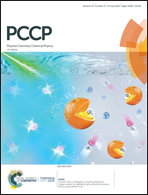Porous and highly conducting cathode material PrBaCo2O6−δ: bulk and surface studies of synthesis anomalies†
Abstract
The paradigm that chemical synthesis reduces the sintering temperature as compared to solid state synthesis seems to be violated in the case of the PrBaCo2O6−δ double perovskite. The sintering temperatures for pure phase samples synthesized through the solid state route (P-SSR) and the auto-combustion route (P-ACR) were found to be 1050 and 1150 °C, respectively. The porous microstructure of P-SSR is suitable for SOFC cathode materials while that of P-ACR is pore free. High-resolution transmission electron microscopy, Raman and scanning tunneling microscopy studies reveal that there is crystal growth on a smooth surface with a preferred orientation. Our results show that this anomalous synthesis behaviour is due to anisotropic surface nucleation growth. Thermodynamically, the higher decomposition temperature in the chemical route is due to stronger electron–phonon coupling and the higher value of change in entropy. The variation in the Co–O–Co bond angle reveals Jahn–Teller vibrational anisotropy in the-b plane leading to the anisotropic synthesis behaviour. This anisotropy is the reason for the violation of the paradigm.



 Please wait while we load your content...
Please wait while we load your content...